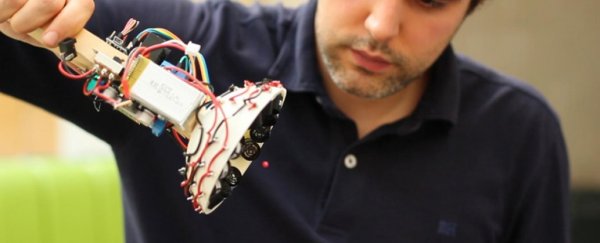Tractor beams and force fields that can invisibly manipulate physical objects are a staple of science fiction, but one day soon they might be something we use in the real world.
Researchers in the UK have demonstrated the world's first sonic tractor beams generated by a single emitter that can move objects around in space with no physical contact. The scientists liken their working tractor beam to an 'acoustic hologram' that can be used like invisible fingers or tweezers to pick up, push and pull small objects.
"In our device we manipulate objects in mid-air and seemingly defy gravity," said Sriram Subramanian, professor of informatics at the University of Sussex. "We can individually control dozens of loudspeakers to tell us an optimal solution to generate an acoustic hologram that can manipulate multiple objects in real-time without contact."
The tractor beam uses an array of 64 miniature loudspeakers that generate a range of high-pitch and high-intensity sound waves capable of moving a small spherical bead made of polystyrene. In addition to levitating the object, the bead can be held in place, moved up, down, and from side to side, and even rotated.
"We all know that sound waves can have a physical effect," said Bruce Drinkwater, professor of ultrasonics at the University of Bristol. "But here we have managed to control the sound to a degree never previously achieved."
At present, the emitter can move objects in three different ways: an acoustic force field, much like fingers, which grips the object; an acoustic vortex, which traps the object at the vortex's core; and a high-intensity cage, that surrounds the object with force from all directions.
The researchers believe their tractor beam could be used for a huge range of potential applications, such as a sonic production line that manufactures delicate objects, or even in medical scenarios, where a miniature emitter could manipulate medicines or microsurgical instruments via completely sterile sound waves.
Some of the researchers are also involved with a company, Ultrahaptics, which envisages an ambitious range of consumer and industrial uses for this kind of technology, such as invisible but tactile control knobs generated by sound, for things like household appliances.
While the tractor beam has only successfully moved a very small and light polystyrene bead, the researchers are busy working on variations that could manipulate both larger and smaller objects. The larger model is intended to levitate a soccer ball from a distance of 10 metres, while a smaller version will be trained to manipulate particles inside the human body.
These achievements might take some time to realise, but the researchers are thrilled to have reached their initial goal with the current model. "It was an incredible experience the first time we saw the object held in place by the tractor beam," said Asier Marzo, lead author of the study. "All my hard work has paid off. It's brilliant."
The research is published in Nature Communications.

